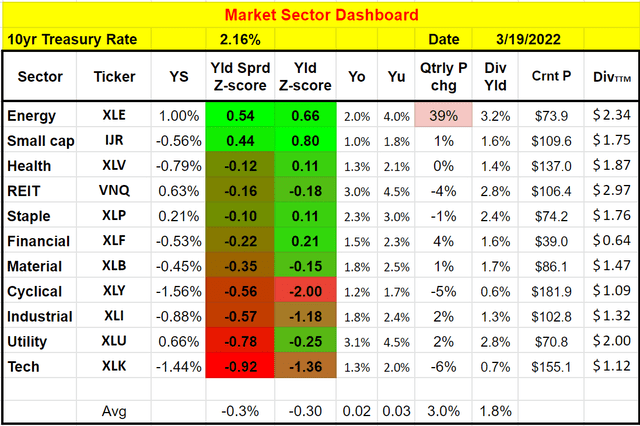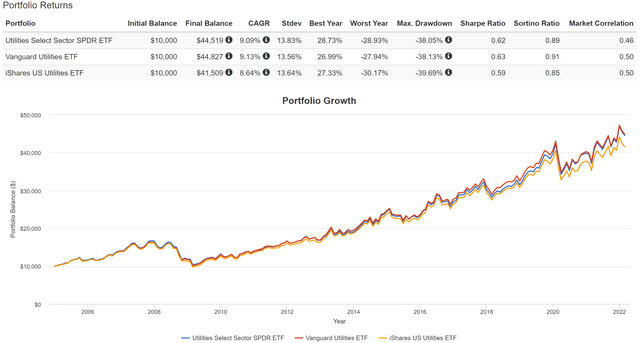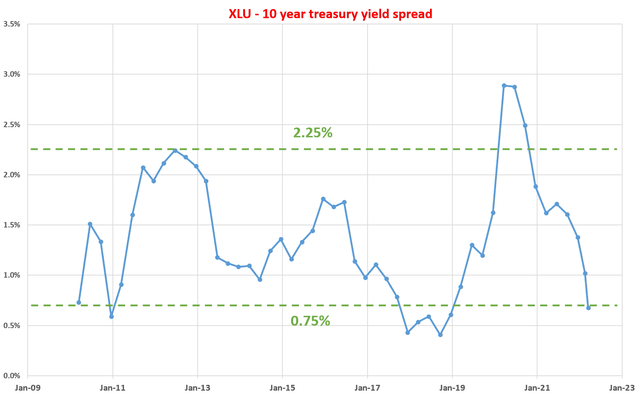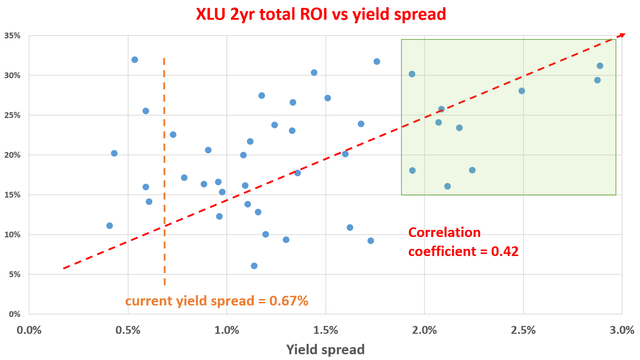[ad_1]
DKosig/iStock via Getty Images
Thesis and Background
We use the following market sector dashboard to put our finger on the pulse of the market and its major sectors. Especially, the simple YS (yield spread, defined as the TTM dividend yield minus the 10-year treasury rates) is the first thing we look at. They give us a 30,000 feet view of where to look further – which sector, growth stocks, value stocks, bonds, or precious metals, et al. We will detail the meaning of each entry in the next section, and we update the dashboard monthly. Feel free to download or export the google-sheet via the following link too: Market Sector Dashboard.
A few overall impressions on the market and the utility sector this month:
- Firstly, the results and dashboard apply to several of the popular utility sector ETFs, such as the Utilities Select Sector SPDR Fund (NYSEARCA:XLU), the iShares U.S. Utilities ETF (NYSEARCA:IDU), and also the Vanguard Utilities Index Fund ETF Shares (VPU). The reason is that these funds are quite similar and their valuation is closely correlated as you can see from the second chart below. As such, this article will present the results for XLU, but the results for the other two funds are essentially identical.
- The yield spread between these utility ETFs and the risk-free rates is currently at their thinnest level in a decade. With a YS Z-score that is significantly negative (-0.78), XLU (and the utility sector in general) is substantially overvalued compared to its historical spectrum.
- As such, the rapid rise of treasury rates has made the yield from utilities very unattractive. The 10-year treasury rates just surged above 2.15% for the first time since July 2019 and are expected to rise further based on the latest Fed dot-plot.
- Although, on the positive side, you will see the fund has never lost money (when adjusted for dividends) in any two-year period in the past decade.
- Finally, the overall market (represented by a simple average of the sectors in the dashboard) also features a slightly negative yield spread relative to the treasury rates (Z-score about -0.3%). It is almost zero. But for us, it is to be monitored closely. If it turns further and more conclusively negative, it then signals that the fundamental dynamics between bond valuation and equity valuation are starting to change. The yield spread Z-score has been positive (or almost positive) since later 2019.
With the above overall discussion, we now move on to the specifics of the dashboard and XLU.
Source: author Source: Portfoliovisualizer.com

The dashboard explained
Note: if you are familiar with our Market Sector Dashboard already, you can skip this section. It describes the mechanics of the dashboard.
- The yield spread Z-score. It gauges the dividend yield of a given sector relative to the 10-year treasury rates. How the yield spread is calculated will be detailed in the next section. A larger Z-score suggests larger undervaluation compared to the historical record and treasury rates. And vice versa.
- A Z-score that is closer to 1 means the yield spread is near the thickest level of the historical spectrum and is color-coded by bright green. And vice versa.
- The yield spread Z-score. Similar to the yield spread Z-score, it gauges the dividend yield of a given sector relative to its own historical record. A larger Z-score (greener) suggests a larger undervaluation compared to its own historical record. And vice versa.
Yield spread and yield spread Z-score
For bond-like equities fund XLU, an effective way to evaluate their valuation with interest rates adjusted is to calculate the yield spread. Details of the calculation and application of the yield spread have been provided in our earlier article. The yield spread is an indicator we first check before we make investment decisions. We’ve fortunately had very good success with this indicator because of:
- Its simplicity – it only relies on the most simple and reliable data points (treasury rates and dividends). In investing, we always prefer a simpler method that relies on fewer and unambiguous data points rather than a more complicated method that depends on more ambiguous data points.
- Its timeless intuition – no matter how times change, the risk-free rate serves as the gravity on all asset valuations and consequently, the spread ALWAYS provides a measurement of the risk premium investors are paying relative to risk-free rates. A large spread provides a higher margin of safety and vice versa.
With this background, you will see below that when adjusted for interest rates, XLU’s current valuation is not at an attractive level.
The following chart shows the yield spread between XLU and the 10-year treasury. The dividend yield is calculated based on the TTM dividends. As can be seen, the spread is bounded and tractable most of the time. The spread has been in the range between about 0.75% and 2.25% the majority of the time during the past decade. Such a tractable YS suggests that when the spread is near or above 2.25%, XLU is significantly undervalued relative to the 10-year Treasury bond (i.e., I would sell treasury bond and buy XLU). In another word, sellers of XLU are willing to sell it (essentially an equity bond with growth built-in) to me at a yield that is 2.25% above the risk-free yield. So it is a good bargain for me. And vice versa.
You can see the screaming signal in 2020 when the yield spread surged to ~3% level – and this is why this dashboard is the first thing we look at when we make our investment decisions.
As of this writing, the spread is about 0.66% as you can see. It is a level that is close to the narrowest end of the historical spectrum in a decade. Such a narrow yield spread signals substantial overvaluation relative to risk-free rates.
Author based on Seeking Alpha data
For readers familiar with our analyses, you know that the short-term returns are closely correlated with the yield spread for many of the funds and stocks. And as you can see from the chart below, it is also true for XLU. This chart shows the 2-year total return on XLU (including price appreciation and dividend) when the purchase was made under different yield spread. There is a clear positive trend and the Pearson correlation coefficient of 0.42.
Again, the screaming buying opportunities in 2020 are shown by the two data points on the far-right side of the charts. And you see the outsized return in the next 2 years. In general, also shown in the green box, when the spread is above ~2%, the total returns in the next one year have been all positive and quite large (all above 15% and as large as 30%+ in three cases).
As of this writing, the yield spread is 0.67% and the YS Z-score is -0.78, close to the narrowest end of the historical spectrum in a decade.
Although, on the positive side, you will see the fund has never lost money in any two-year period in the past decade.
Author based on Seeking Alpha data
Conclusions and final thoughts
We use a Market Sector Dashboard to put a finger on the pulse of the market and its major sectors. For this month, our key observations are:
- With a YS Z-score substantially negative (-0.78), XLU (and other utilities funds such as IDU and VPU) are not attractively valued compared to its historical spectrum.
- The 10-year treasury rates just surged above 2.15% for the first time since July 2019 and are expected to rise further based on the latest Fed dot-plot, further pressuring their valuation.
- Although, on the positive side, these utility funds have never lost money in any two-year period in the past decade.
- Furthermore, the overall market also features a slightly negative yield spread relative to the treasury rates (Z-score about -0.3%). It is almost zero. But for us, it is to be monitored closely as it could signal a fundamental change between bond valuation and equity valuation.
Thx for reading and look forward to your comments!
[ad_2]
Source links Google News

